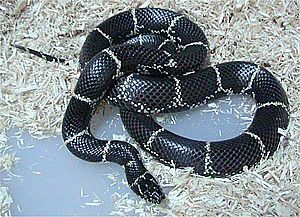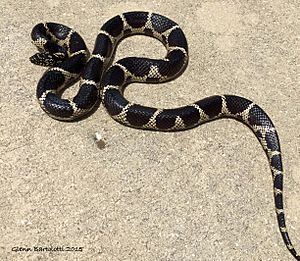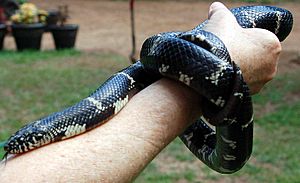Eastern kingsnake facts for kids
Quick facts for kids Eastern kingsnake |
|
|---|---|
 |
|
| Conservation status | |
| Scientific classification | |
| Genus: |
Lampropeltis
|
| Species: |
getula
|
| Synonyms | |
|
|
Lampropeltis getula, commonly known as the eastern kingsnake, common kingsnake, or chain kingsnake (more), is a harmless colubrid species endemic to the United States and Mexico. It has long been a favorite among collectors.Nine subspecies are currently recognized, including the nominate subspecies described here.
Contents
Description

Adult specimens of the speckled kingsnake, L. g. holbrooki, are the smallest race at 91.5 cm (36.0 in) in snout-to-vent length (SVL) on average, while the nominate race, L. g. getula, is the largest at 107 cm (42 in) SVL on average. Specimens up to 208.2 cm (82.0 in) in total length (including tail) have been recorded. Weight can vary from 285 g (10.1 oz) in a small specimen of 87.2 cm (34.3 in) in total length, to 2,268 g (80.0 oz) in large specimens, of over 153 cm (60 in) in total length.
The color pattern consists of a glossy black, blue-black, or dark brown ground color, overlaid with a series of 23-52 white chain-like rings. King snakes from the coastal plains have wider bands, while those found in mountainous areas have thinner bands or may be completely black.
Common names
Common names for L. getula include eastern kingsnake, common kingsnake, chain kingsnake, kingsnake, Carolina kingsnake, chain snake, bastard horn snake, black kingsnake, black moccasin, common chain snake, cow sucker, eastern kingsnake, horse racer, master snake, North American kingsnake, oakleaf rattler, pied snake, pine snake, racer, rattlesnake pilot, thunder-and-lightning snake, thunderbolt, thunder snake, wamper, wampum snake.In North Carolina, it is also called the pied piper.
Geographic range
Lampropeltis getula is found in the United States in Alabama, Arizona, Arkansas, California, portions of Colorado, Delaware, Florida, Georgia, south and southwest Illinois, southern Indiana, southern Iowa, Kansas, Kentucky, Louisiana, Maryland, Mississippi, Missouri, Nebraska, southern and western Nevada, New Jersey, New Mexico, New York, North Carolina, southern Ohio, Oklahoma, southern Oregon, South Carolina, Tennessee, Texas, southern Utah, Virginia, and West Virginia. It is also found in northern Mexico, including all of Baja California. It has been introduced to Gran Canaria in the Canary Islands where, in 2014, it was estimated that the population had reached 20,000 individuals.
Habitat
The preferred habitats of L. getula are open areas, particularly grassland, but also chaparral, oak woodland, abandoned farms, desert, low mountains, sand, and any type of riparian zone, including swamps, canals and streams.
Diet
Lampropeltis getula eats other snakes, including venomous snakes like copperheads (Agkistrodon contortrix) which are responsible for more venomous snakebites than any other in the United States.
It has developed a hunting technique to avoid being bitten by clamping down on the jaws of the venomous prey, but even if bitten, it is immune to the venom. It also eats amphibians, turtle eggs, lizards, and small mammals, which it kills by constriction.
Reproduction
Lampropeltis getula is oviparous. Adult females lay up to several dozen eggs that hatch after 2-2.5 months of incubation. Hatchlings are brightly colored and feed on small snakes, lizards, and rodents.
In captivity
Long a favorite among collectors, L. getula does well in captivity, living to 25 years or more. Some of the most popular subspecies of the common kingsnake kept in captivity are the California, Brooks', Florida, and Mexican black kingsnakes.
Subspecies
| Subspecies | Authority | Common name | Geographic range |
|---|---|---|---|
| L. g. brooksi | Barbour, 1919 | Brooks' kingsnake | |
| L. g. californiae | (Blainville, 1835) | California kingsnake | |
| L. g. floridana | Blanchard, 1919 | Florida kingsnake | |
| L. g. getula | (Linnaeus, 1766) | eastern kingsnake | |
| L. g. holbrooki | Stejneger, 1902 | speckled kingsnake | |
| L. g. nigra | (Yarrow, 1882) | black kingsnake | |
| L. g. nigrita | Zweifel & Norris, 1955 | Mexican black kingsnake | |
| L. g. splendida | (Baird & Girard, 1853) | desert kingsnake | |
| L. g. meansi | Krysko & Judd, 2006 | Apalachicola kingsnake | The Apalachicola Lowlands, Florida |
- Hubbs, Brian (2009). Common Kingsnakes: A Natural History of Lampropeltis getula. Tempe, Arizona: Tricolor Books. 436 pp. ISBN: 978-0975464113.
- Linnaeus C (1766). Systema naturæ per regna tria naturæ, secundum classes, ordines, genera, species, cum characteribus, diferentiis, synonymis, locis. Tomus I. Editio Duodecima, Reformata. Stockholm: L. Salvius. 532 pp. (Coluber getulus, new species, p. 382). (in Latin).
- Powell R, Conant R, Collins JT (2016). Peterson Field Guide to Reptiles and Amphibians of Eastern and Central North America, Fourth Edition. Boston and New York: Houghton Mifflin Harcourt. xiv + 494 pp. ISBN: 978-0-544-12997-9. (Lampropeltis getula, p. 379 + Plate 34).
- Smith HM, Brodie ED Jr (1982). Reptiles of North America: A Guide to Field Identification. New York: Golden Press. 240 pp. ISBN: 0-307-13666-3 (paperback), ISBN: 0-307-47009-1 (hardcover). (Lampropeltis getula, pp. 180-181).
- Stebbins RC (2003). A Field Guide to Western Reptiles and Amphibians, Third Edition. The Peterson Field Guide Series ®. Boston and New York: Houghton Mifflin Company. xiii + 533 pp. ISBN: 978-0-395-98272-3. (Lampropeltis getula, pp. 364-366 + Plate 44 + Map 153).
See also
 In Spanish: Serpiente real común para niños
In Spanish: Serpiente real común para niños



